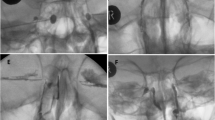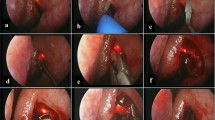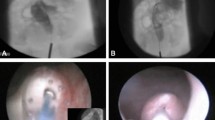Abstract
Purpose: To assess dacryocystoplasty in the treatment of epiphora due to obstructions of the common canaliculus.
Methods: Twenty patients with severe epiphora due to partial (n=16) or complete (n=4) obstruction of the common canaliculus underwent fluoroscopically guided dacryocystoplasty. In all cases of incomplete obstruction balloon dilation was performed. Stent implantation was attempted in cases with complete obstruction. Dacryocystography and clinical follow-up was performed at intervals of 1 week, and 3, 6. 12, and IS months after the procedure. The mean follow-up was 6 months (range 3–18 months).
Results: Balloon dilation was technically successfully performed in all patients with incomplete obstructions (n=16). In three of four patients with complete obstruction stent implantation was performed successfully. Subsequent to failure of stent implantation in one of these patients balloon dilation was performed instead. The long-term primary patency rate in patients with incomplete obstructions was 88% (n=14/16). In three of four cases with complete obstruction long-term patency was achieved during follow-up. Severe complications, infections, or punctal splitting were not observed.
Conclusion: Fluoroscopically guided balloon dacryocystoplasty is a feasible nonsurgical therapy in canalicular obstructions with good clinical results that may be used as an alternative to surgical procedures. In patients with complete obstructions stent placement is possible but further investigations are needed to assess the procedural and long-term results.
Similar content being viewed by others
References
Linberg JV, McCormick SA (1986) Primary acquired nasolacrimal duct obstruction: A clinicopathologic report and biopsy technique. Ophthalmology 93:1055–1063
Traquair HM (1941) Chronic dacryocystitis: Its causation and treatment. Arch Ophthalmol 26:165–180
Kassel EE, Schatz CJ (1995) Lacrimal apparatus. In: Som PM, Curtin HD (eds) Head and Neck Imaging, 3rd edn. Mosby, St Louis, pp 1129–1183
Rose GE, Welham RA (1991) Jones’ lacrimal canalicular bypass tubes: Twenty-five years’ experience. Eye 5:13–19
Hausler R, Caversaccio M (1998) Microsurgical endonasal dacryocystorhinostomy with long-term insertion of bicanalicular silicone tubes. Arch Otolaryngol Head Neck Surg 124:188–191
Song H-Y, Lee C-O, Park S, Sun SW, Yoon HK, Kang S-G, Sung K-B (1996) Lacrimal canaliculus obstruction: Safety and effectiveness of balloon dilation. J Vase Interv Radiol 7:929–934
Pulido-Duque JM, Reyes R, Carreira JM, Vega F, Górriz E, Pardo MD, Perrez F, Maynar M (1998) Treatment of complete and partial obstruction of the nasolacrimal system with polyurethane stents: Initial experience. Cardiovasc Intervent Radiol 21:41–44
Janssen AG, Mansour K, Bos JJ (1997) Obstructed nasolacrimal duct system in epiphora: Long-term results of dacryocystoplasty by means of balloon dilatation. Radiology 205:791–796
Song H-Y, Jin Y-H, Kim J-H, Huh S-J, Kim Y-H, Kom T-H, Sung K-B (1995) Nonsurgical placement of a nasolacrimal polytrethane stent. Radiology 194:233–237
Wilhelm K, Holer U, Textor HJ, Böker T, Strunk H, Schild HH (1999) Dacryoliths: Nonsurgical fluoroscopically guided treatment during dacrycystoplasty. Radiology 212:365–370
Wilhelm K, Textor J, Hofer U, Böker T, Strunk H, Schild H (1997) Nasolacrimal duct obstructions: Treatment with balloon dilation and stent implantation. Fortschr Rontgenstr 167:486–490
Song H-Y, Jin Y-H, Kim J-H, Suh S-W, Yoon Y-K, Kang S-G, Sung K-B (1996) Nonsurgical placement of a nasolacrimal polyurethane stent: Long-term effectiveness. Radiology 200:759–763
Song H-Y, Lee C-O, Park S, Suh SW, Yoon HK, Kang S-G, Sung K-B (1996) Lacrimal canaliculus obstruction: Nonsurgical treatment with a newly designed polyurethane stent. Radiology 199:280–282
Berkefeld J, Kirchner J, Müller HM, Fries U, Kollath J (1997) Balloon dacryocystoplasty: Indications and contraindications. Radiology 205: 785–790
Munk PL, Lin DTC, Morris DC (1990) Epiphora: Treatment by means of dacryocystoplasty with balloon dilatation of the nasolacrimal drainage apparatus. Radiology 177:687–690
Lee JM, Song HY, Han YM, Chung GH, Sohn M-H, Kim K-S, Choi K-C (1994) Balloon dacryocystoplasty: Results in the treatment of complete and partial obstructions of the nasolacrimal system. Radiology 192:503–508
Wilhelm K, Kramer S, Ewen E, Schüller H, Schild H (1998) Radiation exposure of radiation-sensitive risk organs—ocular lens, parotid gland, thyroid gland—in dacryocystography and therapy. Fortschr Rontgenstr 168:270–274
Pinto IT, Paul L, Grande C (1998) Nasolacrimal polyurethane stent: Complications with CT correlation. Cardiovasc Intervent Radiol 21: 450–453
Author information
Authors and Affiliations
Rights and permissions
About this article
Cite this article
Wilhelm, K.E., Hofer, U., Textor, H.J. et al. Nonsurgical fluoroscopically guided dacryocystoplasty of common canalicular obstructions. Cardiovasc Intervent Radiol 23, 1–8 (2000). https://doi.org/10.1007/s002709910001
Issue Date:
DOI: https://doi.org/10.1007/s002709910001




